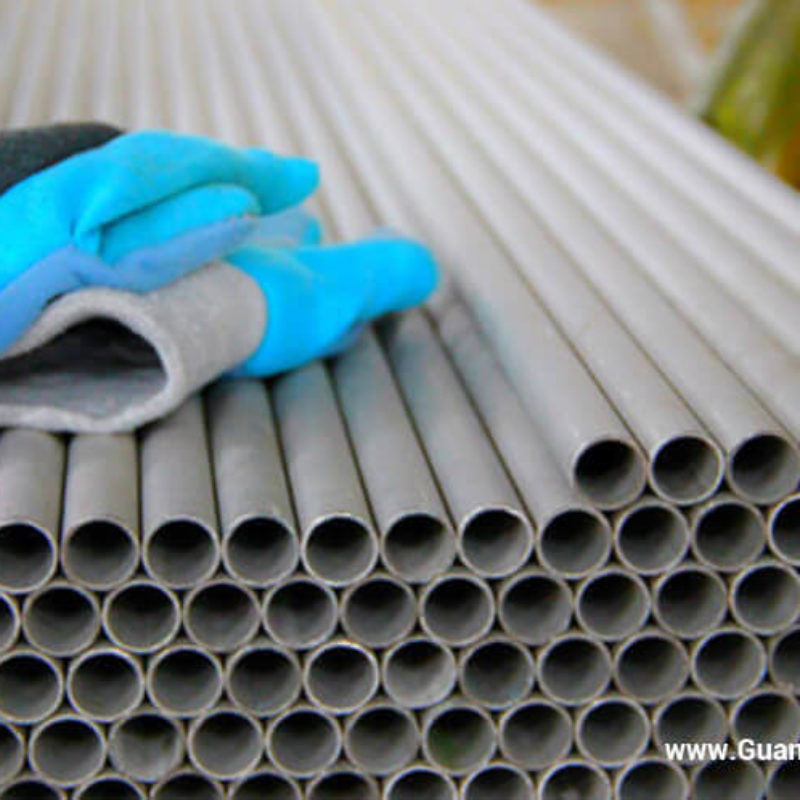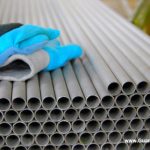304 Stainless Steel Tube SA213 TP304 Stainless Steel Tubes
Request for QuotationGuanyu Tube is specialized Manufacturer of SA213 TP304 Stainless Steel Tubes in China. SA213 TP304 Stainless Steel Tubes have below features.
- Excellent Corrosion Resistance: Good resistance to oxidation and general corrosion in mild environments
- High Temperature Performance: Suitable for intermittent service up to 870°C (1600°F) and continuous service up to 925°C (1700°F)
- Good Formability and Weldability: Can be readily formed and welded by all standard methods
- Non-Magnetic Properties: Austenitic structure provides non-magnetic characteristics in annealed condition
- Hygienic Surface: Smooth surface finish makes it suitable for food and pharmaceutical applications
Precautions for Use SA213 TP304 Stainless Steel Tube
- Avoid Chloride Exposure: Risk of stress corrosion cracking in chloride environments above 60°C
- Welding Considerations: Use low carbon filler metal (ER308L) for heavy sections to prevent carbide precipitation
- Thermal Cycling: Avoid rapid cooling from high temperatures to prevent distortion
- Surface Contamination: Prevent iron contamination which can lead to rust spots
- Intergranular Corrosion: For welded assemblies operating in 425-860°C range, consider stabilized or low-carbon grades
Physical Properties of SA213 TP304
| Properties | Value |
|---|---|
| Density (g/cm³) | 7.93 |
| Melting Range (°C) | 1,400-1,450 |
| Thermal Expansion (10⁻⁶/°C) | 17.2 (20-100°C) |
| Thermal Conductivity (W/m·K) | 16.2 (at 100°C) |
| Electrical Resistivity (Ω·m) | 0.72 × 10⁻⁶ |
Table 1. Chemical Composition for ASME SA 213 ASTM A213 304 304L 304H
| Grade | – | C | Mn | Si | P | S | Cr | Mo | Ni | N |
| 304/S30400 | min.max. | -0.08 | -2.0 | -1.00 | -0.045 | -0.030 | 18.0-20.0 | – | 8.0-11.0 | – |
| EN 10216-5 1.4301 | min.max. | -0.07 | -2.0 | -1.00 | -0.040 | -0.015 | 17.00-19.5 | – | 8.0-10.5 | -0.11 |
| 304L/S30403 | min.max. | -0.035 | -2.0 | -1.00 | -0.045 | -0.030 | 18.0-20.0 | – | 8.0-12.0 | – |
| EN 10216-5 1.4307 | min.max. | -0.030 | -2.0 | -1.00 | -0.040 | -0.015 | 17.5-19.5 | – | 8.0-10.0 | -0.11 |
| 304H /S30409 | min.max. | 0.04-0.10 | -2.0 | -1.00 | -0.045 | -0.030 | 18.0-20.0 | – | 8.0-11.0 | – |
| EN 10216-5 1.4948 | min.max. | 0.04-0.08 | -2.0 | -1.00 | -0.035 | -0.015 | 17.0-19.0 | – | 8.0-11.0 | -0.11 |
Typical Mechanical Properties for grade 304 stainless steel are given in table 2.
Table 2. 304 Stainless Steel Tube Mechanical properties
| – | Tensile Strength | Yield Strength | Elongation | Hardness | Hardness |
| Grade | (MPa) min | 0.2% Proof (MPa) min | (% in 50mm) min | Rockwell B (HR B) max | Brinell (HB) max |
| 304 | 515 | 205 | 35 | 90 | 192 |
| 304L | 485 | 170 | 35 | 90 | 192 |
| 304H | 515 | 205 | 35 | 90 | 192 |
- ASTM: TP304L, TP304
- UNS: S30403, S30400
- EN Number: 1.4306, 1.4301
- W.Nr.: 1.4306*, 1.4301*
- DIN: X 2 CrNi 19 11*, X 5 CrNi 18 10*
- AFNOR: Z 2 CN 18.10*
- BS: 304S31*, 304S11*
- JIS: SUS304L, SUS304LTB, SUS304TP
Product standards
- ASTM A213, A269 and A312
- JIS G3459
- JIS G3463
- EN 10216-5
- BS 3605, 3606*
- DIN 17456, 17458*
- NFA 49-117, 49-217
- SS 14 23 52, 14 23 33*
* Obsolete. Replaced by EN.
Food and Beverage Industry: Processing equipment, piping systems
Chemical Industry: Storage tanks, pressure vessels
Pharmaceutical Industry: Hygienic tubing, process piping
Heat Exchangers: Shell and tube heat exchangers
Boiler Systems: Superheater tubes, boiler tubes
Architectural Applications: Handrails, decorative elements
General corrosion
304 Stainless Steel has good resistance in
- Organic acids at moderate temperatures
- Salt solutions, e.g. sulfates, sulfides and sulfites
- Caustic solutions at moderate temperatures
- Solution Annealing: 1010-1120°C (1850-2050°F)
- Cooling Method: Rapid cooling by water quenching
- Holding Time: Minimum 30 minutes per inch of thickness
- Purpose: To dissolve carbides and achieve optimum corrosion resistance



Referenced Documents
1 Stainless Steel and Related Alloys and is the direct responsibility of Subcommittee A01.10 on Stainless and Alloy Steel Tubular Products. Current edition approved April 1, 2009. Published April 2009. Originally approved in 1939. Last previous edition approved in 2009 as A 213/A 213M – 09.
2 For ASME Boiler and Pressure Vessel Code applications see related Specification SA-213 in Section II of that Code.
ASTM A262 Practices for Detecting Susceptibility to Intergranu lar Attack in Austenitic Stainless Steel
A 941 Terminology Relating to Steel, Stainless Steel, Re lated Alloys, and Ferroalloys
A 1016/A 1016M Specification for General Requirements for Ferritic Alloy Steel, Austenitic Alloy Steel, and Stainless Steel Tubes
ASTM E112 Test Methods for Determining Average Grain Size
Nominal Pipe Size (NPS): 1/8, 1/4, 3/8, 1/2, 3/4, 1, 1 1/4, 1 1/2, 2, 2 1/2 inch
Outside Diameter: 10,3 – 73 mm (0,405 – 2,875 inch)
Wall Thickness: 1,24 – 7,01 (0,049 – 0,276 inch)
Tensile Requirements
| Grade | UNS Designation | Tensile Strength, Min ksi [MPa] | Yield strength, min ksi [MPa] | Elongation in 2 in. or 50 mm, min, %A, B | Hardness, Brinell/Vickers Max | Hardness, Rockwell Max |
| TP304 | S30400 | 75 [515] | 30 [205] | 35 | 192HBW/200Hv | 90HB |
| TP304L | S30403 | 70 [485] | 25 [170] | 35 | 192HBW/200Hv | 90HB |
| TP304H | S30409 | 75 [515] | 30 [205] | 35 | 192HBW/200Hv | 90HB |
| TP304N | S30415 | 80 [550] | 35 [240] | 35 | 192HBW/200Hv | 90HB |
| TP310S | S31008 | 75 [515] | 30 [205] | 35 | 192HBW/200Hv | 90HB |
| TP310H | S31009 | 75 [515] | 30 [205] | 35 | 192HBW/200Hv | 90HB |
| TP316 | S31600 | 75 [515] | 30 [205] | 35 | 192HBW/200Hv | 90HB |
| TP316L | S31603 | 70 [485] | 25 [170] | 35 | 192HBW/200Hv | 90HB |
| TP316H | S31609 | 75 [515] | 30 [205] | 35 | 192HBW/200Hv | 90HB |
| TP316Ti | S31635 | 75 [515] | 30 [205] | 35 | 192HBW/200Hv | 90HB |
| TP317 | S31700 | 75 [515] | 30 [205] | 34 | 192HBW/200Hv | 90HB |
| TP317L | S31703 | 75 [515] | 30 [205] | 35 | 192HBW/200Hv | 90HB |
| TP321 | S32100 | 75 [515] | 30 [205] | 35 | 192HBW/200Hv | 90HB |
| TP321H | S32109 | 75 [515] | 30 [205] | 35 | 192HBW/200Hv | 90HB |
| TP347 | S34700 | 75 [515] | 30 [205] | 35 | 192HBW/200Hv | 90HB |
| TP347H | S34709 | 75 [515] | 30 [205] | 35 | 192HBW/200Hv | 90HB |
| TP444 | S44400 | 60 [415] | 40 [275] | 20 | 217 HBW/230HV | 96HB |
Heat Treatment Requirements
| Grade | UNS Designation | Heat Treat Type | Austenitizing/ Solutioning Temperature, min or range °F [°C] | Cooling Media | ASTM Grain Size No. B |
| TP304 | S30400 | Solution treatment | 1900 °F [1040 °C] | water or another rapid cool | . . . |
| TP304L | S30403 | Solution treatment | 1900 °F [1040 °C] | water or another rapid cool | . . . |
| TP304H | S30409 | Solution treatment | 1900 °F [1040 °C] | water or another rapid cool | 7 |
| TP309S | S30908 | Solution treatment | 1900 °F [1040 °C] | water or another rapid cool | . . . |
| TP309H | S30909 | Solution treatment | 1900 °F [1040 °C] | water or another rapid cool | 7 |
| TP310S | S31008 | Solution treatment | 1900 °F [1040 °C] | water or another rapid cool | . . . |
| TP310H | S31009 | Solution treatment | 1900 °F [1040 °C] | water or another rapid cool | 7 |
| TP316 | S31600 | Solution treatment | 1900 °F [1040 °C] | water or another rapid cool | . . . |
| TP316L | S31603 | Solution treatment | 1900 °F [1040 °C] | water or another rapid cool | . . . |
| TP316H | S31609 | Solution treatment | 1900 °F [1040 °C] | water or another rapid cool | 7 |
| TP317 | S31700 | Solution treatment | 1900 °F [1040 °C] | water or another rapid cool | . . . |
| TP317L | S31703 | Solution treatment | 1900 °F [1040 °C] | water or another rapid cool | . . . |
| TP321 | S32100 | Solution treatment | 1900 °F [1040 °C] | water or another rapid cool | . . . |
| TP321H | S32109 | Solution treatment | cold worked:2000[1090] hot rolled: 1925 [1050]H | water or another rapid cool | 7 |
| TP347 | S34700 | Solution treatment | 1900 °F [1040 °C] | water or another rapid cool | . . . |
| TP347H | S34709 | Solution treatment | cold worked:2000[1100] hot rolled: 1925 [1050]H | water or another rapid cool | 7 |
| TP444 | S44400 | subcritical anneal | . . . | . . . | . . . |
Flattening Test
One flattening test shall be made on specimens from each end of one finished tube, not the one used for the flaring test, from each lot.
Flaring Test
One flaring test shall be made on specimens from each end of one finished tube, not the one used for the flattening test, from each lot.
Hydrostatic or Nondestructive Testing
Each pipe shall be subjected to the nondestructive electric test or the hydrostatic test, the type of test to be used shall be at the option of the manufacturer, unless otherwise specified in the purchase order.
Markings
Markings will adhere to prescribed specifications in A999/A999M and shall include the NPS or OD and schedule number or average wall thickness, heat number, and NH (when hydrotesting is not performed) and ET (when eddy-current testing is performed) or UT (when ultrasonic testing is performed). The marking shall also include the manufacturer’s private identifying mark, the marking requirement of section 12.3 on Hydrostatic or Nondestructive Electric Test, if applicable, and whether seamless (SML), welded (WLD), or heavily cold-worked (HCW). For Grades TP304H, TP316H, TP321H & TP347H, the marking shall also include the heat number and heat-treatment lot identification.
Note:
- Mill test certificates will be issued according to EN10204.3.
- All tubes shall be supplied as per applicable ASTM A213 /A213M Specification.
Notes:
- Steel Grades – TP 304, TP 304L, TP 316, TP 316L, TP 321
- Technical requirements acc. to ASTM A 450.
- Size of pipes in accordance with ANSI/ASME B36.19M.
- The quality of pipes is ensured by manufacturing process and non-destructive test.
- Hardness of metal not less than 100 HB.
- Length tolerance of measured pipes not greater than +10 mm.
- Monitoring of continuity of metal by pneumotest with pressure of 6 bar is available.
- Intergranular corrosion test in accordance with ASTM A262, Practice E is available.


